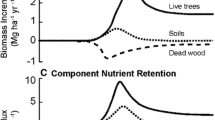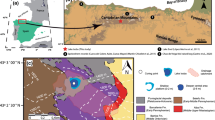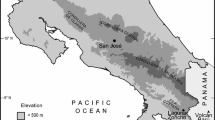Abstract
Stratigraphic shifts in the oxygen isotopic (δ18O) and trace element (Mg and Sr) composition of biogenic carbonate from tropical lake sediment cores are often interpreted as a proxy record of the changing relation between evaporation and precipitation (E/P). Holocene δ18O and Mg and Sr records from Lakes Salpetén and Petén Itzá, Guatemala were apparently affected by drainage basin vegetation changes that influenced watershed hydrology, thereby confounding paleoclimatic interpretations. Oxygen isotope values and trace element concentrations in the two lowland lakes were greatest between ~ 9000 and 6800 14C-yr BP, suggesting relatively high E/P, but pollen data indicate moist conditions and extensive forest cover in the early Holocene. The discrepancy between pollen- and geochemically-inferred climate conditions may be reconciled if the high early Holocene δ18O and trace element values were controlled principally by low surface runoff and groundwater flow to the lake, rather than high E/P. Dense forest cover in the early Holocene would have increased evapotranspiration and soil moisture storage, thereby reducing delivery of meteoric water to the lakes. Carbonate δ18O and Mg and Sr decreased between 7200 and 3500 14C-yr BP in Lake Salpetén and between 6800 and 5000 14C-yr BP in Lake Petén Itzá. This decline coincided with palynologically documented forest loss that may have led to increased surface and groundwater flow to the lakes. In Lake Salpetén, minimum δ18O values (i.e., high lake levels) occurred between 3500 and 1800 14C-yr BP. Relatively high lake levels were confirmed by 14C-dated aquatic gastropods from subaerial soil profiles ~ 1.0–7.5 m above present lake stage. High lake levels were a consequence of lower E/P and/or greater surface runoff and groundwater inflow caused by human-induced deforestation.
Similar content being viewed by others
References
Binford, M. W., E. S. Deevey & T. L. Crisman, 1983. Paleolimnology: An historical perspective on lacustrine ecosystems. Annu. Rev. Ecol. Syst. 14: 255–286.
Binford, M. W., M. Brenner, T. J. Whitmore, A. Higuera-Gundy, E. S. Deevey & B. W. Leyden, 1987. Ecosystems, paleoecology, and human disturbance in subtropical and tropical America. Quat. Sci. Rev. 6: 115–128.
Bosch, J. M. & J. D. Hewlett, 1982. A review of catchment experiments to determine the effect of vegetation changes on water yield and evapotranspiration. J. Hydrol. 55: 3–23.
Bradbury, J. P., B. W. Leyden, M. L. Salgado-Lobouriau, W. M. Lewis Jr., C. Schubert, M. W. Binford, D. G. Frey, D. R. Whitehead & F. H. Weibezahn, 1981. Late Quaternary environmental history of Lake Valencia, Venezuela. Science 214: 1299–1305.
Brenner, M., 1983. Paleolimnology of the Peten Lake district, Guatemala, II. Mayan population density and sediment and nutrient loading of Lake Quexil. Hydrobiologia 103: 205–210.
Brezonik, P. L. & J. L. Fox, 1974. The limnology of selected Guatemalan lakes. Hydrobiologia 45: 467–487.
Bruijnzeel, L. A., 1990. Hydrology of moist tropical forests and conversion: a state of knowledge review. UNESCO-IHP Publication of the Humid Tropics Programme, Paris, 224 pp.
Chivas, A. R., P. De Deckker & J. M. G. Shelley, 1986. Magnesium and strontium in non-marine ostracod shells as indicators of paleosalinity and paleotemperature. Hydrobiologia 143: 135–142.
Chivas, A. R., P. De Deckker, J. A. Cali, A. Chapman, E. Kiss & J. M. G. Shelley, 1993. Coupled stable-isotope and trace-element measurements of lacustrine carbonates as paleoclimatic indicators. In Swart, P. K., K. C. Lohmann, J. McKenzie & S. Savin (eds), Climate Change in Continental Isotopic Records. Am. Geophys. Union, Washington, D.C., 113–121.
Covich, A. P. & M. Stuiver, 1974. Changes in oxygen 18 as a measure of long-term fluctuations in tropical lake levels and molluscan populations. Limnol. Oceanogr. 19: 682–691.
Cowgill, U. M. & G. E. Hutchinson, 1966. A general account of the basin and the chemistry and mineralogy of the sediment cores. In Cowgill, U. M., C. E. Goulden, G. E. Hutchinson, R. Patrick, A. A. Racek & M. Tsukada (eds), The History of Laguna de Petenxil. Memoirs Conn. Acad. Arts Sci. 17: 2–62.
Craig, H., 1961. Isotopic variations in meteoric waters. Science 133: 1702–1703.
Craig, H., 1965. The measurement of oxygen isotope paleotemperatures. In Tongiorgi, E. (ed.), Stable Isotopes in Oceanographic Studies and Paleotemperatures. Consiglio Nazionale delle Richerche, Laboratorio de Geologia Nucleare, Pisa, 161–182.
Curtis, J. H. & D. A. Hodell, 1993. An isotopic and trace element study of ostracods from Lake Miragoane, Haiti: A 10,500-year record of paleosalinity and paleotemperature changes in the Caribbean. In Swart, P. K., K. C. Lohmann, J. McKenzie & S. Savin (eds), Climate Change in Continental Isotopic Records. Am. Geophys. Union, Washington, D.C., 135–152.
Curtis, J. H., D. A. Hodell & M. Brenner, 1996. Climate variability on the Yucatan Peninsula (Mexico) during the past 3500 years, and implications for Maya cultural evolution. Quat. Res. 46: 37–47.
Curtis, J. H., M. Brenner, D. A. Hodell, R. A. Balser, G. A. Islebe & H. Hooghiemstra, 1998. A multi-proxy study of Holocene environmental change in the Maya Lowlands of Petén, Guatemala. J. Paleolim. 19: 139–159.
Dahlin, B. H., 1983. Climate and prehistory on the Yucatán peninsula. Clim. Change 5: 245–263.
Dearing, J. A., 1991. Lake sediment records of erosional processes. Hydrobiologia 214: 99–106.
Dearing, J. A., H. Håkansson, B. Liedberg-Jönsson, A. Persson, S. Skansjö, D. Widholm & F. El-Daoushy, 1987. Lake sediments used to quantify the erosional response to land use change in southern Sweden. Oikos 50: 60–78.
Deevey, E. S., 1978. Holocene forests and Maya disturbance near Quexil Lake, Petén, Guatemala. Pol. Arch. Hydrobiol. 25: 117–129.
Deevey, E. S., 1984. Stress, strain, and stability of lacustrine ecosystems. In Haworth, E. & J. W. G. Lund (eds), Lake Sediments and Environmental History. University of Minnesota Press, Minneapolis, 208–229.
Deevey, E. S., M. Brenner, M. S. Flannery & G. H. Yezdani, 1980. Lakes Yaxha and Sacnab, Petén, Guatemala: limnology and hydrology. Arch. Hydrobiol. 57: 419–460.
Deevey, E. S., D. S. Rice, P. M. Rice, H. H. Vaughan, M. Brenner & M. S. Flannery, 1979. Mayan urbanism: impact on a tropical karst environment. Science 206: 298–306.
Engleman, E. E., L. L. Jackson & D. R. Norton, 1985. Determination of carbonate carbon in geological materials by coulometric titration. Chem. Geol. 53: 125–128.
Engstrom, D. R. & H. E. Wright, 1984. Chemical stratigraphy of lake sediments as a record of environmental change. In Haworth, E. & J. W. G. Lund (eds), Lake Sediments and Environmental History. University of Minnesota Press, Minneapolis, 11–67.
Fisher, M. M., M. Brenner & K. R. Reddy, 1992. A simple, inexpensive piston corer for collecting undisturbed sediment/water interface profiles. J. Paleolim. 7: 157–161.
Fontes, J. C. & R. Gonfiantini, 1967. Comportment isotopic cours de l'evaporation de deux bassins Sahariens. Earth Plan. Sci. Lett. 3: 258–266.
Frey, D. G., 1969. The rationale of paleolimnology. Mitt. Int. Ver. Limnol. 17: 7–18.
Fritz, P., T. W. Anderson & C. F. W. Lewis, 1975. Late-Quaternary climatic trends and history of Lake Erie from stable isotope studies. Science 190: 267–269.
Gasse, F., R. Techet, A. Durand, E. Gilbert & J. C. Fontes, 1990. The arid-humid transition in the Sahara and Sahel during the last glaciation. Nature 346: 141–146.
Gat, J. R., 1984. The stable isotope composition of Dead Sea waters Earth Plan. Sci. Lett. 71: 361–376.
Gonfiantini, R., 1965. Isotopic effects in the evaporation of salt water. Atti. Soc. Toscana Nat. Sci. Pisa 72: 5–22.
Hastenrath, S., 1976. Variations in low-latitude circulation and extreme climatic events in the tropical Americas. J. Atmos. Sci. 33: 202–215.
Hastenrath, S., 1984. Interannual variability and the annual cycle: mechanisms of circulation and climate in the tropical Atlantic sector. Mon. Wea. Rev. 112: 1097–1107.
Hibbert, A. R., 1967. Forest treatment effects on water yield. In Sopper, W. E. & H. W. Lull (eds), Proc. Int. Symp. For. Hydrol., University Park, PA, August 29-September 10, 1965. Pergamon, Oxford, 527–543.
Higuera-Gundy, A., M. Brenner, D. A. Hodell, J. H. Curtis, B. W. Leyden & M. W. Binford, 1999. A 10,300 14C yr record of climate and vegetation change from Haiti. Quat. Res. 52: 159–170.
Hodell, D. A., J. H. Curtis & M. Brenner, 1995. Possible role of climate in the collapse of Classic Maya civilization. Nature 375: 391–394.
Hodell, D. A., J. H. Curtis, G. A. Jones, A. Higuera-Gundy, M. Brenner, M. W. Binford & K. T. Dorsey, 1991. Reconstruction of Caribbean climate change over the past 10,500 years. Nature 352: 790–793.
Holmes, J. A., 1996. Trace-element and stable-isotope geochemistry of non-marine ostracod shells in Quaternary palaeoenvironmental reconstruction. J. Paleolim. 15: 223–235.
Hornbeck, J. W. & W. T. Swank, 1992. Watershed ecosystem analysis as a basis for multiple use management of eastern forests. Ecol. Appl. 2: 238–247.
Imboden, D. M. & A. Lerman, 1978. Chemical models of lakes. In Lerman, A. (ed.), Lakes: Chemistry, Geology, and Physics. Springer-Verlag, New York, 341–356.
Islebe, G., H. Hooghiemstra, M. Brenner, J. H. Curtis & D. A. Hodell, 1996. A Holocene vegetation history from lowland Guatemala. The Holocene 6: 265–271.
Leyden, B. W., 1984. Guatemalan forest synthesis after Pleistocene aridity. Proc. Natl. Acad. Sci. USA 81: 4856–4859.
Leyden, B. W., 1985. Late Quaternary aridity and Holocene moisture fluctuations in the Lake Valencia Basin, Venezuela. Ecology 66: 1279–1295.
Leyden, B. W., 1987. Man and climate in the Maya lowlands. Quat. Res. 28: 407–414.
Leyden, B. W., M. Brenner & B. H. Dahlin, 1998. Cultural and climatic history of Cobá, a lowland Maya city in Quintana Roo, Mexico. Quat. Res. 49: 111–122.
Leyden, B. W., M. Brenner, D. A. Hodell & J. H. Curtis, 1993. Late Pleistocene climate in the Central American lowlands. In Swart, P. K., K. C. Lohmann, J. McKenzie & S. Savin (eds), Climate Change in Continental Isotopic Records. Am. Geophys. Union, Washington, D.C., 165–178.
Leyden, B. W., M. Brenner, D. A. Hodell & J. H. Curtis, 1994. Orbital and internal forcing of climate on the Yucatan Peninsula for the past ca. 36 ka. Palaeogeogr. Palaeoclim. Palaeoecol. 109: 193–210.
Lister, G. S., K. Kelts, C. K. Zao, J. Yu & F. Niessen 1991. Lake Qinghai, China: closed-basin lake levels and the oxygen isotope record of ostracoda since the latest Pleistocene. Palaeogeogr. Palaeoclim. Palaeoecol. 84: 141–162.
Lundell, C. L., 1937. The vegetation of Petén. Carnegie Inst., Washington, DC., 244 pp.
Mason, I. M. M. A. J. Guzkowska, C. G. Rapley & F. A. Street-Perrott, 1994. The response of lake levels and areas to climatic change. Clim. Change 27: 161–197.
Oldfield, F., 1978. Lakes and their drainage basins as units of sediment-based ecological study. Prog. Phys. Geogr. 1: 460–504.
Pearson, F. J. & T. B. Coplen, 1978. Stable isotope studies of lakes. In Lerman, A. (ed.), Lakes: Chemistry, Geology, and Physics. Springer-Verlag, New York, 325–339.
Pennington, W., 1981. Records of a lake's life in time: the sediments. Hydrobiologia 79: 197–219.
Phillips, F. M., M. A. Person & A. B. Muller, 1986. A numerical lumped parameter model for simulating the isotopic evolution of closed-basin lakes. J. Hydrol. 85: 73–86.
Piperno, D. R., M. B. Bush & P. A. Colinvaux, 1990. Paleoenvironments and human settlements in late-glacial Panama. Quat. Res. 33: 108–116.
Rice, D. S., P. M. Rice & E. S. Deevey, 1985. Paradise lost: Classic Maya impact on a lacustrine environment. In Pohl, M. (ed.), Prehistoric Lowland Maya Environment and Subsistence Economy. Harvard University Press, Cambridge, 91–105.
Sahin, V. & M. J. Hall, 1996. The effects of afforestation and deforestation on water yields. J. Hydrol. 178: 294–309.
Simmons C. S., J. M. Tarano & J. H. Pinto, 1959. Clasificacion de reconocimiento de los suelos de la Republica de Guatemala. Ministerio de Agricultura, Guatemala City, 1000 pp.
Stednick, J. D., 1996. Monitoring the effects of timber harvest on annual water yield. J. Hydrol. 176: 79–95.
Street-Perrot, F. A., 1995. Natural variability of tropical climates on 10–100-year time scales: Limnological and paleolimnological evidence. In Martinson, D. G., K. Bryan, M. Ghil, M. M. Hall, T. R. Karl, E. S. Sarachik, S. Sorooshian & L. D. Talley (eds), Natural Climate Variability on Decade-to-Century Time Scales. National Academy Press, Washington D.C., 506–511.
Stuiver, M., 1968. Oxygen-18 content of atmospheric precipitation during the last 11,000 years in the Great Lakes region. Science 162: 994–997.
Stuiver, M., 1970. Oxygen and carbon isotope ratios of freshwater carbonates as climatic indicators. J. Geophys. Res. 75: 5247–5257.
Stuiver, M., P. J. Reimer, E. Bard, J. W. Beck, G. S. Burr, K. A. Hughen, B. Kromer, G. McCormac, J. van der Plicht & M. Spurk, 1998. INTCAL98 radiocarbon age calibration, 24,0000 cal BP. Radiocarbon 40: 1041–1083.
Talbot, M. R., 1990. A review of the palaeohydrological interpretation of carbon and oxygen isotopic ratios in primary lacustrine carbonates. Chem. Geol. 80: 261–279.
Tsukada, M., 1966. The pollen sequence. In Cowgill, U. M., C. E. Goulden, G. E. Hutchinson, R. Patrick, A. A. Racek & M. Tsukada (eds), The History of Laguna de Petenxil. Memoirs Conn. Acad. Arts Sci. 17: 2–62.
Vaughan, H. H., E. S. Deevey & S. E. Garrett-Jones, 1985. Pollen stratigraphy of two cores from the Petén lake district, with an appendix on two deep-water cores. In Pohl, M. (ed.), Prehistoric Lowland Maya Environment and Subsistence Economy. Harvard University Press, Cambridge, 73–89.
Vinson, G. L., 1962. Upper Cretaceous and Tertiary stratigraphy of Guatemala. Amer. Assoc. Petrol. Geol. Bull. 46: 425–456.
Xia, J., E. Ito & D.R. Engstrom, 1997. Geochemistry of ostracode calcite: Part 1. An experimental determination of oxygen isotope fractionation. Geoch. Cosmoch. Acta. 61: 377–382.
Walling, D. E., 1988. Erosion and sediment yield research-some recent perspectives. J. Hydrol. 100: 113–141.
Wilson, E. M., 1980. Physical geography of the Yucatán Peninsula. In Moseley, E. H. & E. D. Terry (eds), Yucatán: A World Apart. University of Alabama Press, Tuscaloosa, 5–40.
Wright, H. E. Jr., D. H. Mann & P. H. Glaser, 1984. Piston corers for peat and lake sediments. Ecology 65: 657–659.
Author information
Authors and Affiliations
Rights and permissions
About this article
Cite this article
Rosenmeier, M.F., Hodell, D.A., Brenner, M. et al. Influence of vegetation change on watershed hydrology: implications for paleoclimatic interpretation of lacustrine δ18O records. Journal of Paleolimnology 27, 117–131 (2002). https://doi.org/10.1023/A:1013535930777
Issue Date:
DOI: https://doi.org/10.1023/A:1013535930777




